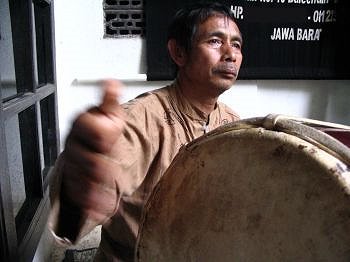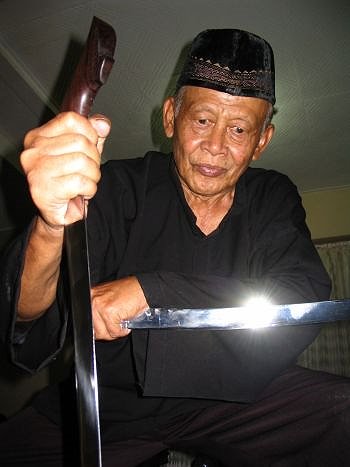Fight-choreography in West Java is a source of cultural pride
Paul H. Mason
Pak Haji Uho performingPaul Mason |
Haji Uho Holidin is a 72 year old performer who lives in Bandung, West Java. He is a senior teacher in Pencak Silat Panglipur Pamager Sari, a club that teaches and performs pencak silat seni. This is a movement art based on the fighting techniques of pencak silat, the authentic martial art of the Indo-Malayan archipelago. Pencak silat practitioners consider it to be a sport, an art, a form of combat training and a tool for mental and spiritual development. Panglipur Pamager Sari is a prestigious school that attracts a large number of local students of all ages, both male and female.
Despite his advanced age, Haji Uho still actively surveys and monitors the progress of students. Training usually takes place after Isha prayer on Tuesday nights at a performance space near his home. Devoted students also schedule their own training sessions in their respective suburbs. At training, Haji Uho teaches movements and explains their functions, urging students to understand the intent of each movement so that their performances are both meaningful and attractive. Younger students model their performances on Haji Uho’s moves, which are still graceful and powerful despite his age.
Pencak silat as cultural art
While pencak silat is traditionally regarded as a sport for men, the artistic component of pencak silat seni offers women an attractive way to learn fighting skills. The beauty of the music and the choreographed movement allow practitioners to enjoy the art without the pain and struggle of combat practice. Dian Nur Dini, a 22 year old female performer who has toured Korea and Malaysia with Panglipur Pamager Sari, said ‘Women must know how to defend themselves. Inside the beautiful music and movement of pencak silat seni, there are effective combat techniques.'
Pencak silat practitioners consider it to be a sport, an art, a form of combat training and a tool for mental and spiritual development
For dedicated practitioners like Dian, pencak silat seni offers opportunities to travel to other countries. But it is certainly no way to earn a good living. Even a well known and respected pencak silat teacher like Haji Uho has to run his own business. Haji Uho does not request payment for teaching pencak silat. To make money, he makes clothes for pencak silat performers. As a sign of appreciation and respect, his students and his students’ students buy their silat costumes from him. He employs a small number of young tailors to sew the clothes which he sells to schools in Bandung as well as to some affiliated training centres in Europe. At night, if Haji Uho is not training students in the front room of his house, he will often be found in his workroom (which is also his kitchen) cutting material and preparing silat clothes. For Haji Uho, it is a business of love. He believes that the art form fulfils a human need for beauty, and he gets great pleasure from creating pencak silat costumes that add to the beauty of the performances.
Music for the fight
 |
Pak Oseng playing the double sided barrel drumPaul Mason |
In West Java, pencak silat seni is accompanied by a variety of local instruments. The most important of these instruments are the kendang (a double-sided barrel drum), the tarompet (a double-reed woodwind instrument) and the gong. The drums are used to accompany and illustrate the performers’ movements. There are a variety of different rhythms which all have different origins, like the rhythm known as Paleredan, from the village of Palered, and Tepak Dua, from Cimande. The drummers follow the movements of the performer with their playing, and develop great sensitivity to the choreographed movements of the art form.
Pak Darman Santikahidayat is one of several blind musicians who accompany pencak silat performances and competitions throughout Bandung. He accompanies pencak silat on the double-reed tarompet, matching the rhythm and tempo of the performances. Although he cannot communicate through gestures or observation, Pak Darman can nevertheless respond immediately to changes in rhythm, speed and excitement. As he can play both woodwind and string instruments, he receives many invitations to perform at local events.
Being a musician enables Pak Darman to earn money and avoid the hardships often faced by people with disabilities in Indonesia. When not playing music, Pak Darman works as a masseur, an occupation not uncommon for blind people in Indonesia. Most of Darman’s patients arrive in the late afternoon or evening. During the morning to early afternoon, Pak Darman sometimes gives music lessons. However, music lessons, massage patients and music performances arrive sporadically, so a steady income is never a certainty.
From improvisation to choreography
Maenpo is a form of pencak silat from from Cikalong, Cianjur (West Java). It differs in two ways from contemporary pencak silat seni. Pencak silat seni is largely a choreographed art form in which the movements are illustrated by the music. By contrast, maenpo is based on improvisation. The music is also different. Maenpo performers are accompanied by the zither and bamboo flute, a pairing that creates a soothing, melancholic atmosphere. To this music, they practice mostly soft and slow movements, punctuated with fast and lethal attacks and blocks.
The word maenpo is an abbreviation of ‘maen poho’ which means to play with your partner’s forgetfulness. The idea is to remember all your moves and to capitalise on the forgetfulness of your adversary. If a practitioner forgets to keep guard then the opponent can take advantage of the opportunity and win. If, however, the opponent forgets to take advantage of an opportunity, then it is he who loses the game. The soft lulling music ensures that this contest does not develop into a fight.
Maenpo has few followers in contemporary West Java. The popularity of the improvisation-based forms of pencak silat like maenpo have declined as the choreographed forms of pencak silat seni have become more popular. According to Haji Uho, pencak silat has undergone many changes since Indonesian independence in 1945, especially since the establishment of organisations that have systematised and standardised pencak silat. This has created a trend away from spontaneous improvisation such as maenpo to rehearsed choreography.
Sundanese audiences become very involved in the performance. The music is loud, and the audiences love to add to the atmosphere by shouting in time with the music and crying out their support for the performers
The modern, choreographed form of pencak silat in West Java is performed at weddings and circumcision ceremonies. Clubs come together at contests and festivals to demonstrate and sometimes test their skills with one another. Sundanese audiences become very involved in the performances. The music is loud, and the audiences love to add to the atmosphere by shouting in time with the music and crying out their support for the performers. The double reed tarompet player contributes to the festive vibe by playing songs that match the tone of the performance and the audience’s reaction.
Using the movements of the improvised art-form as building blocks, the choreography has developed to allow the expression of a certain kind of cultural memory that gives important meaning to the music and movement. Haji Uho has been a key figure in developing many new choreographies based on the material taught to him by his teacher, Abah Aleh (who is said to have lived from 1856 to 1980). These choreographies are much loved by the West Javanese and are a source of cultural pride. Dian Nur Dini states, ‘Apart from being a hobby and a great way to keep fit, pencak silat is part of being Indonesian. It is a way for me to preserve my culture.’ As Dian Nur Dini suggests, pencak silat is part of Indonesia’s rich cultural heritage. From the young practitioners to the handicapped and elderly, it empowers communities and adds beauty to the lives of those who encounter it. ii
Paul H. Mason (paul.mason@scmp.mq.edu.au ) is a PhD candidate in Anthropology at Macquarie University in Sydney. He is researching practices of fight-dancing in Indonesia and Brazil.












